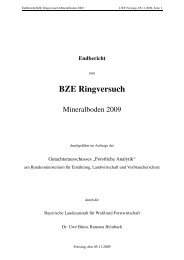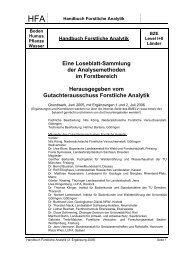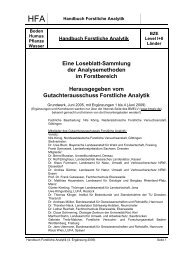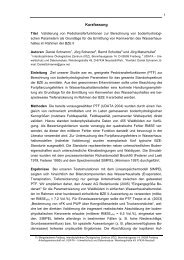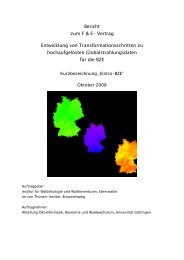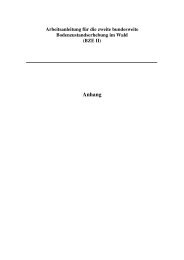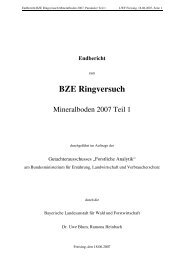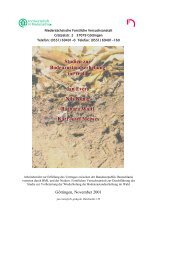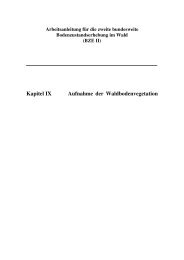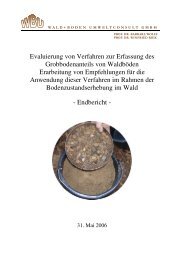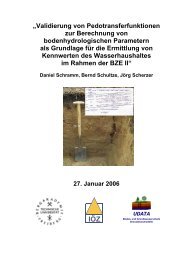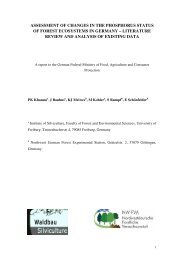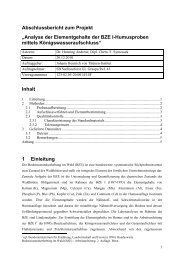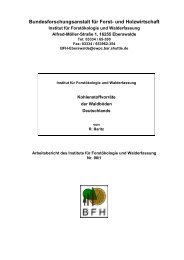assessment of changes in the phosphorus status of forest ...
assessment of changes in the phosphorus status of forest ...
assessment of changes in the phosphorus status of forest ...
Create successful ePaper yourself
Turn your PDF publications into a flip-book with our unique Google optimized e-Paper software.
The frequency and <strong>the</strong> amount <strong>of</strong> mast production has <strong>in</strong>creased <strong>in</strong> recent decades<br />
probably due to <strong>in</strong>creased N atmospheric <strong>in</strong>puts and high vitality <strong>of</strong> trees. This may<br />
<strong>in</strong>crease <strong>the</strong> amount <strong>of</strong> P required for <strong>the</strong> growth <strong>in</strong> beech <strong>forest</strong>s, which may be 2-3<br />
times <strong>the</strong> amount <strong>of</strong> P required dur<strong>in</strong>g mast years when compared to non-mast years.<br />
Bauhus (1994) reported for a beech stand <strong>in</strong> <strong>the</strong> Soll<strong>in</strong>g area that <strong>the</strong> concentration <strong>of</strong><br />
P <strong>in</strong> seeds (4.8 mg g -1 ) was more than 5 times that <strong>in</strong> leaves (0.9 mg g -1 ).<br />
That <strong>phosphorus</strong> can become growth limit<strong>in</strong>g dur<strong>in</strong>g vegetation succession was<br />
shown conclusively by Wardle et al. (2004) who studied six long-term<br />
chronosequences, <strong>in</strong> Australia, Sweden, Alaska, Hawaii, and New Zealand. Dur<strong>in</strong>g<br />
succession, ecosystem development occurred; but <strong>in</strong> <strong>the</strong> long-term absence <strong>of</strong><br />
catastrophic disturbance, a decl<strong>in</strong>e phase eventually would follow. The decl<strong>in</strong>e phase<br />
was associated with a reduction <strong>in</strong> tree basal area and an <strong>in</strong>crease <strong>in</strong> <strong>the</strong> substrate<br />
nitrogen–to-<strong>phosphorus</strong> ratio (<strong>in</strong> <strong>the</strong> litter layer), <strong>in</strong>dicat<strong>in</strong>g <strong>in</strong>creas<strong>in</strong>g <strong>phosphorus</strong><br />
limitation over time. These <strong>changes</strong> were <strong>of</strong>ten associated with reductions <strong>in</strong> litter<br />
decomposition rates, <strong>phosphorus</strong> release from litter, and biomass and activity <strong>of</strong><br />
decomposer microbes.<br />
1.4 Possible causal mechanisms <strong>of</strong> decrease <strong>in</strong> P <strong>status</strong> <strong>of</strong> trees<br />
A number <strong>of</strong> causal mechanisms have been proposed to expla<strong>in</strong> <strong>the</strong> association<br />
between <strong>the</strong> appearance <strong>of</strong> P deficiencies <strong>in</strong> <strong>forest</strong> trees receiv<strong>in</strong>g high atmospheric<br />
<strong>in</strong>puts <strong>of</strong> acids and nitrogen. Some <strong>of</strong> <strong>the</strong>se are given below: (i) Soil acidification is<br />
hypo<strong>the</strong>sised to cause an <strong>in</strong>crease <strong>in</strong> <strong>the</strong> <strong>in</strong>organic P sorption capacity <strong>of</strong> <strong>the</strong> soils and<br />
concomitant decreases <strong>in</strong> P solubility (Van Breemen et al., 1983; Pare´ and Bernier<br />
1989b). (ii) Soil acidification may reduce <strong>the</strong> rate <strong>of</strong> organic P m<strong>in</strong>eralisation<br />
(Harrison 1982; Pare´ and Bernier 1989a). (iii) High atmospheric N <strong>in</strong>puts may<br />
enhance <strong>the</strong> tree demand for o<strong>the</strong>r nutrients (especially P), potentially result<strong>in</strong>g <strong>in</strong><br />
nutritional imbalances (Nihlgard 1985; B<strong>in</strong>kley et al. 1989). (iv) P uptake may be<br />
reduced due to a decrease <strong>in</strong> f<strong>in</strong>e roots and mycorrhizal associations (Arnebrant and<br />
Soderstrom 1992, Gundersen 1998) due to high acidity and high levels <strong>of</strong> N <strong>in</strong> soils.<br />
However, <strong>the</strong> establishment <strong>of</strong> clear l<strong>in</strong>kages between observed P deficiency<br />
symptoms and any <strong>of</strong> <strong>the</strong> proposed causal mechanisms has been difficult <strong>in</strong> <strong>the</strong> abovecited,<br />
field-based studies describ<strong>in</strong>g ‘natural’ variability.<br />
17



